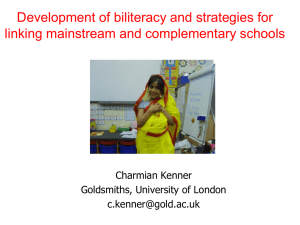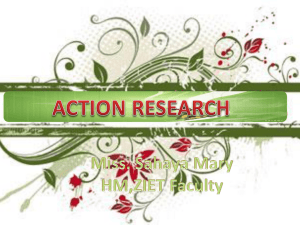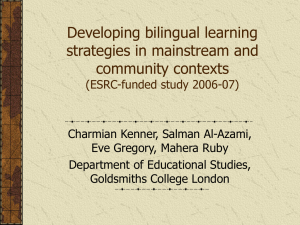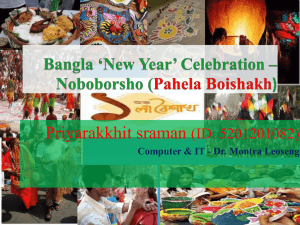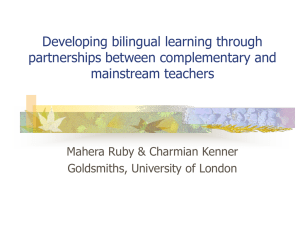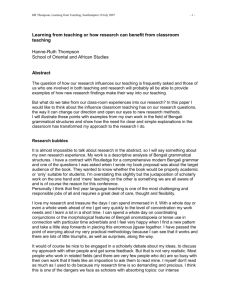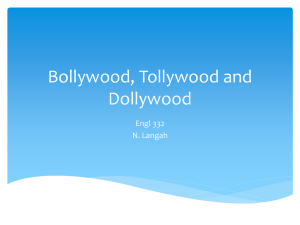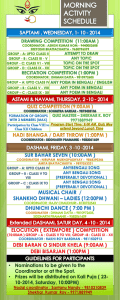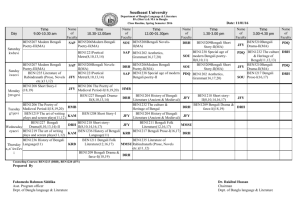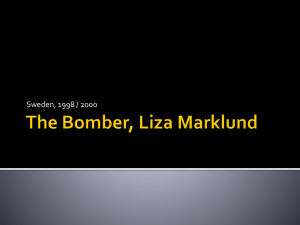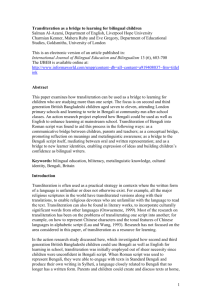Bilingual learning: bringing in the wider world
advertisement
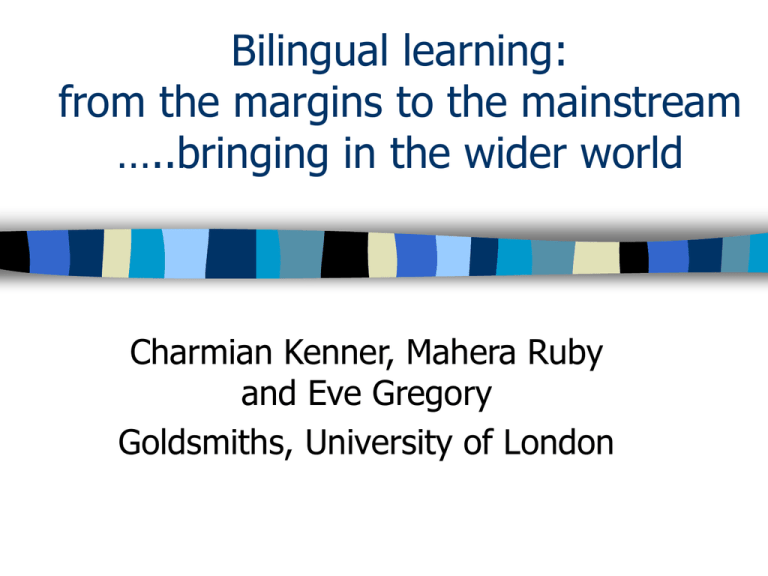
Bilingual learning: from the margins to the mainstream …..bringing in the wider world Charmian Kenner, Mahera Ruby and Eve Gregory Goldsmiths, University of London Complex classroom contexts Smithy Street Primary School, East London Year 5 class, majority second and third generation British Bangladeshi children Some children with other languages: Arabic, Urdu Dual heritage children: Arabic/Somali, Urdu/Bengali Newcomer child from Bangladesh Teaching assistants bilingual in Sylheti/Bengali Teacher bilingual in Swedish Only English being used in class History of work with this school Previous project: value of bilingual learning for second/third generation children (Kenner, Ruby, Gregory and Al- Azami, Language, Culture and Curriculum 21 (2), 2008) Children learning Bengali at community-run after-school classes but not confident to use Bengali in mainstream class Working bilingually in mainstream developed conceptual understanding, cultural knowledge, metalinguistic skills, learner identities School recognised community classes as source of knowledge, chose Bengali as ‘modern foreign language’ New project: partnerships between primary and community teachers (funded by Paul Hamlyn Foundation and Tower Hamlets) Collaborative action research on bilingual learning Teachers visit each other’s settings Plan jointly around a topic, adapt to own context Deliver lessons and observe each other Plan and deliver again Supported by Goldsmiths and Tower Hamlets Languages Service Community school partner: Stifford Centre Bengali classes (thanks to www.stifford.org.uk for the image) 2 blocks away from primary school 3 year programme in Bengali and Arabic, 5 days a week, 5-7 pm, 3 classes Headteacher and own curriculum Supported by Tower Hamlets Languages Service Sulaman and Annika: poetry work Kajla Didi: well-known Bengali poem about a girl whose sister has mysteriously disappeared What Happened to Lulu?: English poem by Charles Causley with very similar subject matter Kenner et al (2008) Bilingual poetry: expanding the cognitive and cultural dimensions of children’s learning. Literacy 42 (2) Transliterated and translated versions Kajla Didi by Jatindra Mohon Bagchi Baash baganer mather upor chad uteche oi Mago amaar solok bola Kajla didi koi? Pukur dhare, nebur tole thokai thokai jonak jole Phooler gondhe ghum ase na ekla jege roi Maago amar koler kache Kajla didi koi? The moon has appeared on the top of the bamboo garden Mother, where is my quiz teller sister Kajla? Near the pond and underneath the lemon plant The flowers’ smell kept me awake and it’s only me who is awake Mother, where is my very dear sister Kajla? (Transliteration and translation by Shabita Shamsad) Bilingual learning approaches Use all three versions of Kajla Didi to investigate meaning Involve parents and grandparents: ask for poems in other languages Compare Kajla Didi and What Happened to Lulu Write own poems about loss, using Bengali / English / other languages Sulaman’s community class Switching between Bengali script, transliteration and English Sulaman talks of learning ‘in between’: ‘once they do all those, it will stay in their mind’ Annika comments: ‘I wish I could teach bilingually like you’ Annika’s mainstream class Write questions for parents (support from bilingual assistant): take home overnight Bring back answers and more poems:present to class Compare answers in groups: make posters in different languages Children’s responses Almost all children had discussed with parents or grandparents – Annika: ‘very good, especially when you only had one night to do it in…you even stepped out of the house on a cold winter’s night to do it’ Children brought similar poems in Urdu and Arabic, a short Bengali play, and one child translated the entire poem into Spanish with his father’s help Annika: ‘You’re all very talented children’ Children: ‘We’ve got talent!’ Annika: ‘Smithy Street’s got talent!’ Multiple aspects of learning Literary heritage: importance of poem, use of poetry recitation and songs Natural history: plants, birds, insects in other countries Social and cultural knowledge: village life, living close to nature, gender relationships Linguistic knowledge: word meanings, issues in translation Inclusion: voicing each other’s knowledge Empathy: teacher shared Swedish lullaby Support for home language writing Child new to English but expert writer in Bengali – could interpret poem for others: Sulaman commented ‘in the writing, he expressed himself and he got confidence in the class…he got something and he felt proud of it’ Sulaman’s presence encouraged writing in Bengali script: children became gradually more confident to show what they could do Community teacher is clear about their role: bilingual assistants hesitant at first Annika’s comments:a wider world of learning ‘It’s about the whole child really for me…just by having contact with their community schools I feel I can understand a bit more about their learning in a broader context – they’ve got skills we don’t always use in class and doing the poetry work has given us the chance to use some of those skills…it was lovely to see the confidence of the children who were able to take on the task and engage with it, using their mother tongue, it just felt very positive to see them, and then opening up the doors to some other children…if we hadn’t done the project I wouldn’t have known that Ibraheem could translate a poem into Spanish with his dad’s help or that Asya had learnt all these childhood rhymes and songs and I didn’t know that she was able to recite and learn off by heart, so I learned about her as a learner and I learnt a bit more about the context that she comes from and the language experience she has at home which is more complex than I knew…’ Annika’s comments:a wider world of learning ‘I think it was about their pride as well, that was a very important part of the work, their pride and self-esteem, it was about acknowledging who they are as individuals, I think it’s a very important part of children’s development, that they feel proud of who they are and they can celebrate their skills, and that school is a place where we acknowledge the broad skills that children have….obviously English is what we’re being asked to teach but what I think I learned from this is that children who are actually being very successful in English seem to also be children who are engaging with mother tongue classes as well’ Where next? Sulaman and Annika are one of 12 teacher partnerships at 2 primary schools: Somali and Russian community schools also involved Year 2: dissemination in Tower Hamlets and nationally via resources/training Smithy Street and Stifford Centre: working together Outstanding inspection report at Smithy Street: areas to work on are partner/group work to encourage independent learning for pupils, further partnership with parents concerning children’s learning – these are areas the research can inform Stifford Centre has applied for funding to run a language/culture club with Smithy Street ‘Think tank’ involving both organisations – draw on children’s broader learning skills and involve families as partners in education – open up to the wider world of learning
